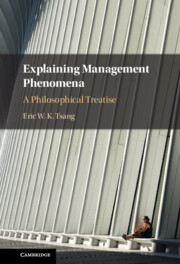Book contents
- Explaining Management Phenomena
- Explaining Management Phenomena
- Copyright page
- Contents
- Figures and Tables
- Preface
- Articles
- Chapter 1 The Nature of Explanation
- Chapter 2 Causation
- Chapter 3 Modes of Explanation
- Chapter 4 Microfoundations
- Chapter 5 Theory versus Non-theory–Based Explanation
- Chapter 6 Multi-theoretical Explanation
- Chapter 7 Research Methods
- Chapter 8 Explanation as Science (or Art?)
- Appendix Chinese Philosophy and Scientific Research
- Notes
- References
- Index
Chapter 1 - The Nature of Explanation
Published online by Cambridge University Press: 15 December 2022
- Explaining Management Phenomena
- Explaining Management Phenomena
- Copyright page
- Contents
- Figures and Tables
- Preface
- Articles
- Chapter 1 The Nature of Explanation
- Chapter 2 Causation
- Chapter 3 Modes of Explanation
- Chapter 4 Microfoundations
- Chapter 5 Theory versus Non-theory–Based Explanation
- Chapter 6 Multi-theoretical Explanation
- Chapter 7 Research Methods
- Chapter 8 Explanation as Science (or Art?)
- Appendix Chinese Philosophy and Scientific Research
- Notes
- References
- Index
Summary
This introductory chapter discusses the nature of explanation. It first distinguishes between the epistemic versus ontic conceptions of explanation; the former deems that explanations explain by subsuming a phenomenon under a general proposition while the latter regards explanations as physical entities residing and participating in the causal structure of the world. Using the example of entrepreneurial opportunities, the chapter describes how an ontological position plays a role in shaping an explanation. Explanation promotes understanding. However, tautological explanations, such as Barney’s (1991) explanation of competitive advantage based on firm resources, do not increase our understanding of the phenomenon in question. Then the chapter discusses the contrastive approach to explanation, showing that an explanation is necessarily incomplete. The discussion is followed by examining whether causal explanations have to be general and whether good explanations have to be interesting. The chapter ends with a brief description of the subsequent chapters of the book.
Keywords
- Type
- Chapter
- Information
- Explaining Management PhenomenaA Philosophical Treatise, pp. 1 - 31Publisher: Cambridge University PressPrint publication year: 2022

